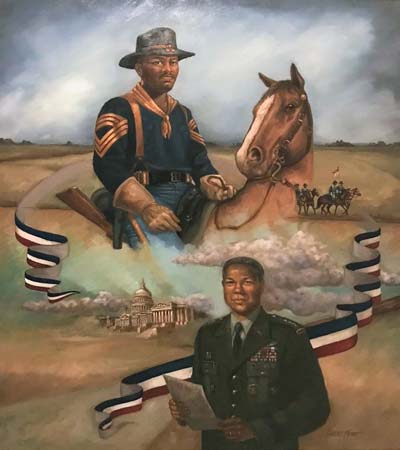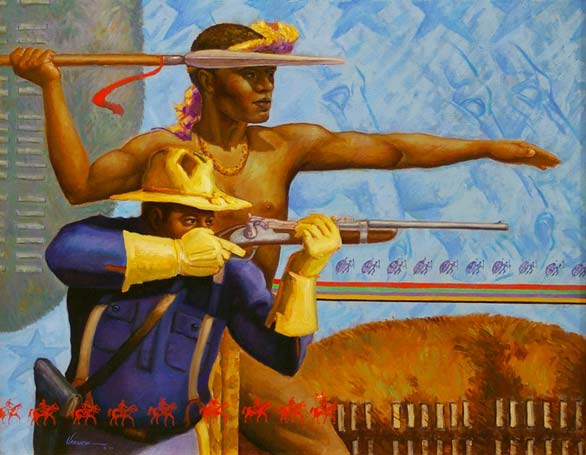Advisory Board Member and Past President
By Suzanne Lavone Smith, PSA Advisory Board, Past President

As the Portrait Society of Atlanta recently celebrated our 45th Anniversary, it is an especially appropriate time to recognize those who have most significantly contributed to our longevity. One of our most knowledgeable administrative leaders was Advisory Board Member and Past President Ernest Varner, who passed on September 24, 2024.
For the benefit of less familiar members, I’ve included some details from my 1998 Folio Spotlight article on Ernest mingled with some 2007 comments from another Advisory Board Member and Past President who was instrumental in organizing the PSA bylaws and administrative structure, the late Dona R. Sawhill.
Ernest Varner grew up in Chattanooga, Tennessee, where his father was a minister and his mother received recognition as the state’s first female African-American deputy police chief. Ernest began his formal study of art in high school where he benefited from a strong art program. He also studied painting and drawing at Hunter Museum of Art in Chattanooga and continued to study art at the University of Tennessee at Chattanooga (UTC).

The war in Vietnam and the draft played an important role in his decision to join the Reserve Officers’ Training Corps with a plan of serving his country. In 1972, Ernest graduated from UTC with a Bachelor’s in Psychology and a minor in Art. He then joined the Army as a Medical Service Corps Officer.
Ernest had always wanted to pursue being an artist, so throughout his military travels, he used museums and galleries as classrooms in which he copied works on display. He knew that after 20 years of service, he could retire with a pension to back up his art career goals. So, in 1994, Lieutenant Colonel Varner retired while serving as Troop Commander at Blanchfield Army Community Hospital, Fort Campbell, Kentucky. He was awarded the Legion of Merit for 22 years of dedicated service to his country, which included two wars. While on active duty, Ernest completed several graduate-level courses in counseling with Boston University, and earned a Master’s in General Administration from Central Michigan University.

After retirement, Ernest continued his art studies with such masters of portraiture as David Leffel, Ken Marlow, Daniel Greene, Jim Schell, Richard Whitney, Marc Chatov, Margaret (Peggy) Carter Baumgaertner, Nelson Shanks, John de la Vega, Burt Silverman, Bart Lindstrom, and Michael Del Priore, among others. As Director over Workshops, Ernest was instrumental in bringing to Atlanta many of these artists to teach fellow members of the PSA.
Possessing an unquenchable thirst for knowledge in all facets of life, Ernest maintained his spiritual/physical balance and focus on creativity, assisted in part by his martial arts training where he held a black belt. As a lifelong Christian and healthy lifestyle devotee, he combined his prayer life with meditation and would recall visions to inspire his paintings. He also enjoyed the renewing energy of spending quiet time in nature. He stated, “Having a diverse overview of life is one of the biggest things going for me and can be one of the best teachers for artists in general.” He was frequently quoted as saying, “We are at our best when we are being creative. It is at this point when we are most like our Creator.”



Ernest’s distinguished military reputation and diplomatic skills, coupled with his stature as an artist, led to his being invited by the US State Department to participate in the Art in Embassies program. For three years, Ernest had five original paintings on display at the American Embassy in Botswana, Africa. When visiting the embassy, Ernest gave lectures, taught classes, and conducted demonstrations as a U.S. Ambassador of Good Will. He was then invited to two separate events – one at the White House and one at the State Department – to participate in the 40th anniversary of the Art in Embassies Program. The two events recognized artists who had contributed to the success of that program. First Lady Laura Bush and Secretary of State Colin Powell wanted to thank him personally, along with other participating artists. Ernest also traveled to South Africa in 2001 to present one of his limited-edition prints, “The Longest Mile,” to the U.S. Ambassador to South Africa.
In addition to his commissioned work, Ernest enjoyed great success with limited-edition print collectors and became well known for his Christian and African-American ethnic imagery. His imaginative approach and inspired imagery were his personal forms of Christian ministry. Ernest received several awards during his career in art. His paintings are on exhibit in collections around the world to include The Booth Western Art Museum in Cartersville, Georgia, where he was honored to have one of his images selected as part of the Booth’s permanent collection.

For more than 20 years, Ernest taught art and lectured at Kennesaw State University (Continuing Education Program) and various art centers throughout greater Atlanta. His popularity as an artist led him to be invited as juror for events such as the Dogwood Festival, the Roswell Art Festival, and others. He was offered several book deals, gallery exhibitions, and other business ventures regarding his art.
In addition to his various leadership roles in the Portrait Society of Atlanta, Ernest was a member of the Portrait Society of America and served on the Advisory Board of Gallery 4463, in Acworth, Georgia.



My personal thoughts
At first impression, his strong, military demeanor and disciplined serious expression could be intimidating. But Ernest possessed a hilarious dry wit and gentle personality, if you knew how to read his subtle clues. Some might be surprised to learn that (according to his lovely wife, Jackie) he briefly considered going into stand-up comedy.

His work was beautiful, spiritual, uplifting, and inspirational. I was most intrigued with his use of color. To look at the rainbow of subtle hues he included in what would otherwise be a blue sky or patch of dirt made me understand how color-blind people might feel when putting on those glasses that allow them to see color for the first time.
Ernest helped others discover their creativity and get “in the zone.” He instinctively or intuitively knew what people needed to hear and shared his enlightenment freely.
I was privileged to serve for roughly 25 years with Ernest and others in PSA leadership. As volunteer coworkers, we came through so much that it felt like we were old war buddies. I learned about life from Ernest, and learned about myself. He helped me grow into a better, more confident person. I truly loved him as my “brother-from-another-mother.” His life with us was, and now his absence is, tremendously impactful. Our memories of Ernest will be treasured for the rest of our lives – but beyond that, “I have no doubt in my military mind” that his art will live on.
More comments from PSA friends
Peggy Sullens:
PSA Treasurer
I became acquainted with Ernest when I signed up for his portrait painting class at the Pinckneyville Recreation Center in Norcross. I had been looking for a portrait class and my friend Kaly Susky was taking Ernest’s class. Kaly recommended him, and I am so glad she did. Ernest had a teaching style that was so easy to understand. He was so brilliant and loved to share his knowledge and skills. I would take paintings to his home in Acworth to get critiques, which helped me immensely. His sense of humor made all of his students feel at home and important. I told Ernest on a regular basis that I loved him and he did the same with me. I often told him, too, that I had learned more from him than any instructor I ever had. He was a very special man that I will never forget.
Carol Kirby:
PSA Advisory Board, Past President
I had the privilege of serving with Ernest for many years and learned much from him as a leader. He was serious about business, quick to listen to all viewpoints, and slow to speak. He had a dry sense of humor that would catch me off guard at times – ending with lots of laughs. Quietly looking for ways to bless other people, he touched many lives in small and large ways. I was often the recipient of his grace and blessings.
Ann Bailey:
PSA Director, Past President
More than anyone else I’ve ever been around, Ernest grasped what it takes to understand and guide a group of people. Working alongside Ernest in our 501(c)3 corporation, I received training that turned out to be one of the most valuable sets of information anyone can get. I have been and will always be in debt and in gratitude to Ernest for his generous and patient mentorship of me.
My heart goes out to his wife, Jackie, always cheerful, always present, always generously sharing so much of your love with us.
Nancy Honea:
PSA Advisory Board, Past President, Accreditation Chair
Ernest was a bright shining light in my life and in so many others. In his quietly dignified manner, he was a strong leader, kind, brilliant, and deeply caring. His spiritual life led him and his devotion to his wife Jackie sustained him. I respected Ernest for his principles and beliefs.
He was wonderful to work with in PSA. Ernest skillfully handled workshops for many years; gave insightful, entertaining critiques; and served as a steadying voice on the Advisory Board.
After a career in the military, Ernest pursued his art with passion, and his teaching with generosity. He valued my artistic knowledge and often asked for a critique of his painting. We attended each other’s PSA Critique sessions as we supported each other and learned. His humor was a joy.
Ernest’s deeply intuitive understanding of people was enlightening. We had many conversations after PSA meetings, critiques, and workshops. Over 20+ years we grew to be trusting and caring friends. I valued his wisdom.
It was a privilege to be his loyal friend. Ernest was a gift in my life, and I miss him.
Dona R. Sawhill (Reprinted from 2007):
PSA Advisory Board, Past President
Rarely do we have artists volunteering for an unpaid, time-consuming administrative position who actually have training and over 22 years of experience in leadership and administrative management. Despite his administration’s inheritance of some complex organizational issues, Ernest faithfully led our Society toward a more logical structure that will continue to bring benefits for the Society as his ideas are implemented. One of the most significant contributions of his presidency has been to lead this administration in revising bylaws. This accomplishment strengthened the organization’s internal structure and improved checks and balances. Ernest fought for the continued benefit of members without personal gain and at great cost against unfair resistance. Due to the time demands of volunteering as PSA’s President and the accompanying challenges which needed resolving at that time in our history, he declined several profitable art career offers. That kind of selfless dedication is to be respected and the PSA should be deeply indebted to him for these personal and professional sacrifices. I’d like to express my sincerest appreciation for all he has done for this organization.


